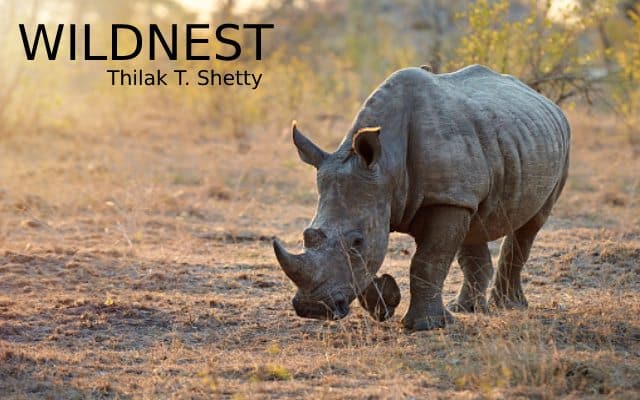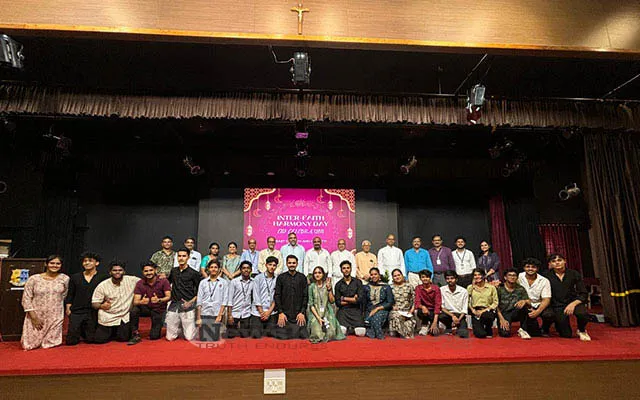Rhinoceros, a giant horn-bearing herbivores commonly called as Rhino is a member of any of the five extant species of Rhinocerotidae family. Two of the extant species are native to Africa, and three to South and Southeast Asia. They are commonly found in habitats such as Tropical bushland, grassland and savannas. While Rhinos historically roamed across most of sub-Saharan Africa and SE Asia, today an estimated 85% of living Rhinos are located in just one country – South Africa.
Rhinoceroses are characterised by the possession of one or two horns on the upper surface of the snout and these horns are not true horns but are composed of keratin, a fibrous protein found in hair. Female Javan Rhinos are notable in that they often lack a horn or have a smaller “bump” on their nose.
Modern rhinoceroses are large animals, ranging from 2.5 metres long and 1.5 metres high at the shoulder. All weigh at least one tonne in adulthood. Rhinoceroses are noted for their thick skin, which forms platelike folds, especially at the shoulders and thighs. They have a robust, cylindrical body with a large head, relatively short legs, and short tail. All Rhinos are grey or brown in colour including the white Aside from the Sumatran Rhinoceros. They are nearly or completely hairless except for the tail tip and ear fringes but some fossil species were covered with dense fur. The feet of the modern species have three short toes, tipped with broad, blunt nails. Rhinoceros, which tends to be paler than the others.
Most Rhinoceros are solitary. Individuals usually avoid each other but the white Rhinoceros lives in groups of up to 10 animals. In solitary species the home territory is criss-crossed with well-worn trails and often marked at the borders with urine and piles of dung.
Rhinoceroses have poor eyesight but acute senses of hearing and smell. Most prefer to avoid humans but males, and females with calves, may charge with little provocation. Despite their bulk, Rhinoceroses are remarkably agile; the black Rhinoceroses can attain a speed of about 45 km (30 miles) per hour, even in thick brush, and can turn around rapidly after missing a charge. Like elephants, Rhinoceroses communicate using infrasonic frequencies that are below the threshold of human hearing.
One of the features of very large body size in mammals is a low reproductive rate. In Rhinoceroses, females do not conceive until about six years of age, gestation is long (16 months in most species), and they give birth to only one calf at a time. The period of birth between calves can range from 2 to 4.5 years. The loss of a number of breeding-age females to poachers can greatly slow the recovery of Rhinoceros populations. However, a female Rhinoceros will conceive again quickly if she loses her calf. In this species tigers kill about 10 to 20 percent of calves. Tigers rarely kill calves older than 1 year, so those Indian Rhinoceroses that survive past that point are invulnerable to nonhuman predators. Adult Rhinoceros have no real predators in the wild, other than humans. Young Rhinos sometimes fall prey to big cats, crocodiles, African wild dogs, and hyenas. They are very easily poached as they visit water holes daily and can be easily killed while they drink water. Rhinoceros are killed by poachers for their horns, which are bought and sold on the black market for high prices, leading to most living Rhinoceros’ species being considered endangered. The contemporary market for rhino horn is overwhelmingly driven by China and Vietnam, where it is bought by wealthy consumers to use in traditional Chinese medicine, among other uses. Market also exists for rhiyno horn dagger handles in Yemen, which was the major source of demand for Rhino horn in the 1970s and 1980s.
Beyond this, the largest animal of the land has gained special place in history.
Greek Historian and Geographer Agatha Chides mentions the Rhinoceros in his book On the Erythraeid Sea.
Albrecht Dürer created a famous woodcut of a Rhinoceros in 1515, based on a written description and brief sketch by an unknown artist of an Indian Rhinoceros that had arrived in Lisbon earlier that year. He never saw the animal itself, so Dürer’s Rhinoceros is a somewhat inaccurate depiction.
Rhinoceros are depicted in the Chauvet Cave in France, pictures dated to 10,000–30,000 years ago.
There are legends about Rhinoceroses stamping out fire in Burma, India, and Malaysia.
The mythical Rhinoceros has a special name in Malay, Badak api, wherein Badak means Rhinoceros, and api means fire. The animal would come when a fire was lit in the forest and stamp it out. There are no recent confirmations of this phenomenon. This legend was depicted in the film The Gods Must Be Crazy (1980), which shows an African Rhinoceros putting out two campfires.
In 1974 a Lavender Rhinoceros symbol began to be used as a symbol of the gay community in Boston.



















